Rebecca’s Recipe of the Week: Roast Parsnips, Lentils, Cheese
Here we have a warm, sustaining main-course salad made bright with greens and the bite of mustard. It’s a good use of that parsnip that’s still in your fridge. You can make a meal of this, along with some good bread and a glass of red wine.
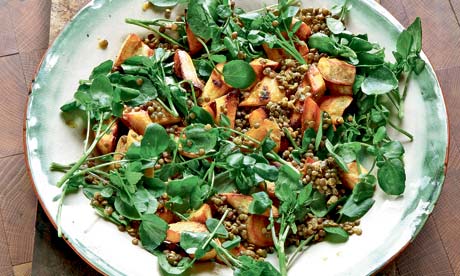
Roast Parsnip, Watercress and Lentil Salad
Serves 3
Ingredients
Salad
5 medium parsnips
2 tablespoons oil
salt and pepper
125g Puy or green lentils
2 bay leaves
1 medium onion, unpeeled
several parsley stems (optional)
several big handfuls of watercress or rocket
any hard cheese, to shave over the top
Salad dressing
1 clove garlic
½ teaspoon salt
1 teaspoon English mustard
2 teaspoons runny honey
1 tablespoon lemon juice
4 tablespoons rapeseed oil
Preparation
Preheat your oven to 190C.
Peel the parsnips and cut them into chunky batons. Toss them with the oil and a sprinkling of salt and pepper. Tip them onto a baking tray and roast for 30-40 minutes, or until they are tender and a bit golden. The time will depend on how large they are. You can poke them with a fork to see if they are soft inside. Remove from the oven and leave them to one side.
Meanwhile, prepare the lentils: cover them with boiling water and bring back to a boil. Boil for one minute, and then drain.
Return the drained lentils to the pan and add just enough water to cover them. Add the bay leaves, onion and parsley stalks (if you have any to hand). Bring to the boil, reduce to a simmer, and simmer for about 30 minutes, or until al dente. Drain and remove the bay leaves and parsley. It’s up to you either to remove the onion or to leave it in the finished salad.
While the lentils cook and the parsnips roast prepare the salad dressing. Mash the garlic with the salt in a mortar and pestle to make a smooth paste. Whisk in the other ingredients.
When the parsnips and lentils are finished, toss them, still warm, with the dressing and add the watercress or rocket. Pile onto a serving platter and shave some hard cheese over the top before serving.
Recipe adapted from Hugh Fearnley-Whittingstall, River Cottage Veg Every Day! (2011) – online at rivercottage.net
Rob’s Recipe of the Week: Celeriac Soup
I wasn’t sure Celeriac soup was a good choice, but we’ve had a few Celeriacs recently and I fancied a change. It was a pleasant surprise, then, that this turned out to be super tasty in an intensely savoury way. Even better was that we risked eating it after forgetting to put it away overnight and so far we have survived!
Cream of celeriac soup
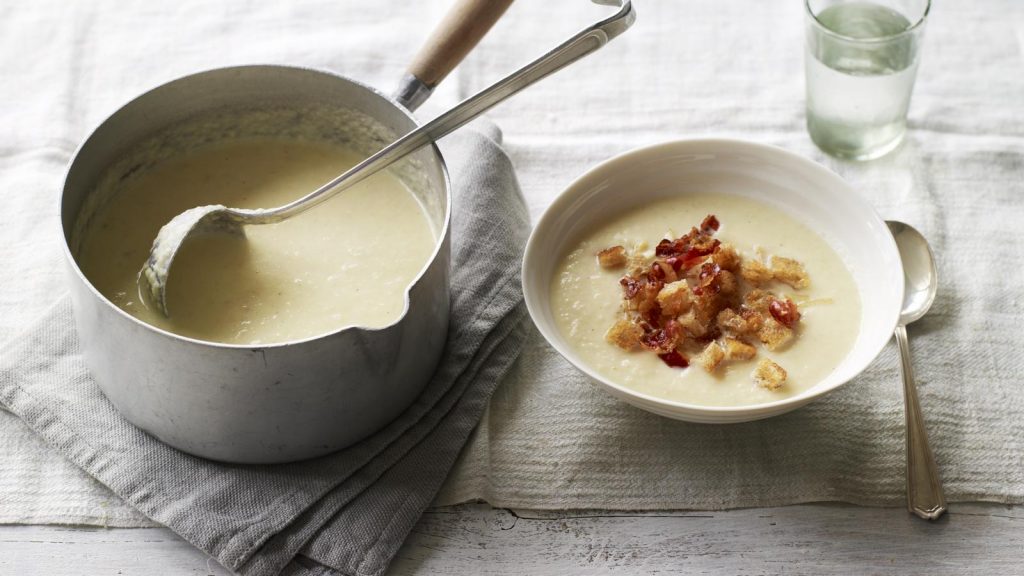
Ingredients
For the soup
75g/3oz butter
1 onion, finely chopped
50g/2oz streaky bacon, cut into small pieces (optional)
2 garlic cloves, finely chopped
1 leek, white only, finely chopped
1 stick celery, finely chopped
2 thyme sprigs, leaves picked
700g/1lb 8oz celeriac, peeled and cut into small cubes
1 litre/1¾ pint vegetable stock
200ml/7floz double cream
salt and white pepper
Method
For the soup, heat a large frying pan or saucepan until medium hot, add 25g/1oz of the butter, the onion and bacon and fry for a couple of minutes to just soften. Add the garlic, leek, celery and thyme sprigs and fry for another minute; then add the chopped celeriac. Pour in the stock and bring to the boil, then reduce the heat to a simmer and cook for 10-15 minutes, or until the celeriac is just tender.
Blend the soup to a fine purée using a stick blender or a blender. Return to the heat in a pan. Add the cream and whisk in the remaining 50g/2oz of butter.
Season with salt and white pepper. Serve the hot soup in bowls.
There is an optional garnish which can be found at the link to the recipe.
From BBC Food.
Rebecca’s Recipe of the Week: A Restorative Soup
This is what you need if you have eaten a lot of rich food over the holidays. The lentil soup is soothing, but not at all boring, enlivened as it is with marinated artichoke hearts and a swirl of yoghurt. You will feel better after eating this, I promise. Note, too, that it uses some of those leeks, carrots and celery that have accumulated in your fridge from the double share.
Lentil Soup with Artichoke
Serves 4
Ingredients
2 tablespoons olive oil
2 leeks, trimmed, halved lengthwise and sliced thin
3 medium carrots, peeled, halved lengthwise and sliced thin
4 celery sticks, sliced thin
1 heaped tablespoon grated fresh ginger
1 Canalside chile, left whole
4 cloves of garlic, peeled and chopped fine
250g green lentils
2 tablespoons cider vinegar
1.5l stock or water
1 teaspoon salt
5 heaped tablespoons coarsely chopped parsley
120g artichoke hearts from a jar, drained and sliced thin, to serve
plain or Greek yoghurt, to serve (if desired)
Preparation
Heat the oil over medium heat in a large saucepan with a lid. When it is warm add the leeks, carrots, celery, ginger and chile. Fry for about 10 minutes, or until the vegetables have softened and are starting to colour.
Add the garlic and stir for a few minutes more.
Stir in the lentils, and add the vinegar and water. Bring to a boil and simmer until the lentils are tender—20-30 minutes, probably. Add some more water if they seem dry.
Purée about a third of the soup in a liquidiser or food processor, and then stir this back into the pan. Add the salt and stir in most of the parsley, keeping back a little for a garnish.
Dish into bowls and place a sliced artichoke heart in the centre of each bowl. Sprinkle the remaining parsley over the top. Serve with a spoonful of yoghurt on top, if desired.
Recipe adapted from Annie Bell, Plant Power: Protein-rich Recipes for Vegetarians and Vegans (2020).
Rob’s Recipe of the Week: Caramelised Cabbage
This recipe isn’t so Christmassy, but I did enjoy it. I found the liquid took a lot longer than stated to reduce, but in the end I would actually have preferred a bit more sauce when serving. Goes well with mash!
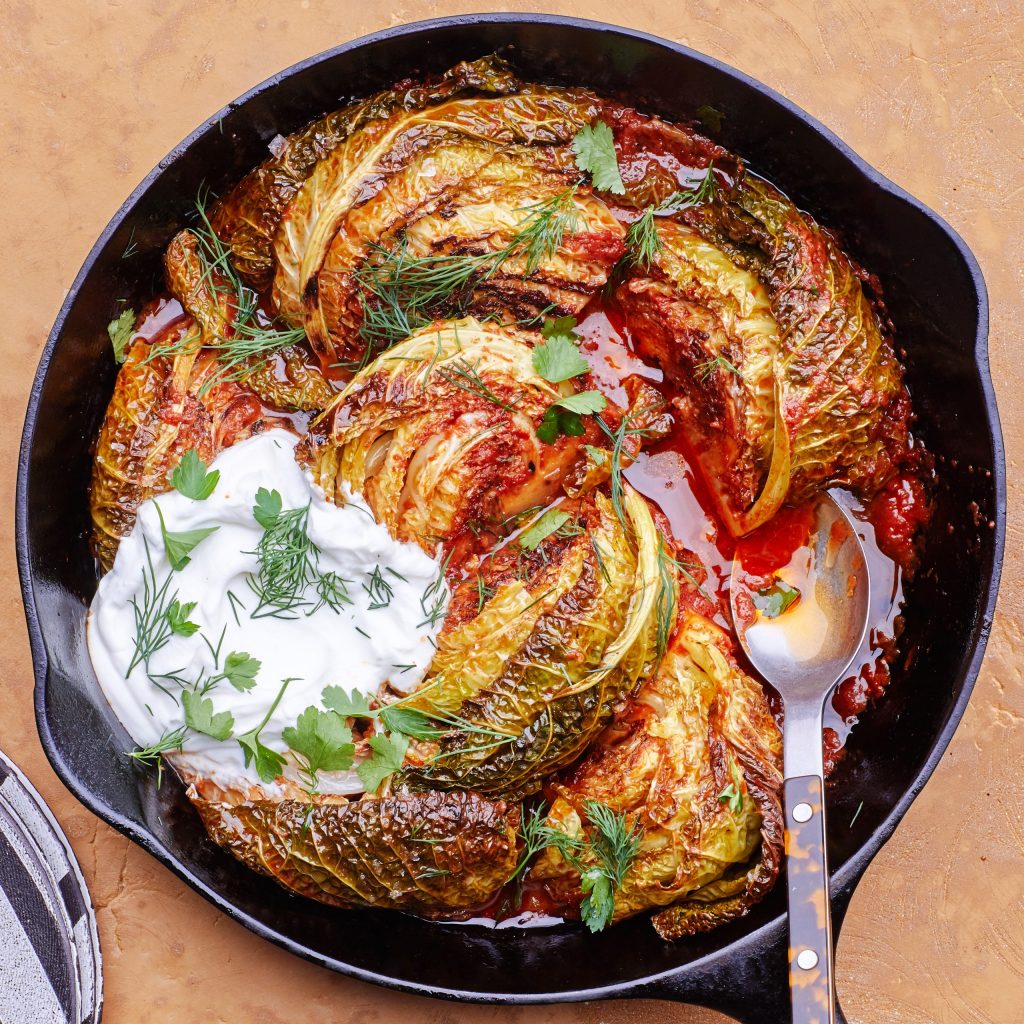
Ingredients
¼ cup double-concentrated tomato paste
3 garlic cloves, finely grated
1½ tsp. ground coriander
1½ tsp. ground cumin
1 tsp. crushed red pepper flakes
1 medium head of green cabbage
½ cup extra-virgin olive oil, divided
Salt
3 Tbsp. chopped dill, parsley, or coriander
Full-fat Greek yogurt or sour cream (for serving)
Method:
Preheat oven to 180°. Mix tomato paste, garlic, coriander, cumin, and red pepper flakes in a small bowl.
Cut cabbage in half through the core. Cut each half through the core into 4 wedges.
Heat ¼ cup oil in a large oven safe frying pan (or similar) over medium-high. Working in batches if needed, add cabbage to the pan cut side down and season with salt. Cook, turning occasionally, until lightly charred, about 4 minutes per side. Transfer cabbage to a plate.
Pour remaining ¼ cup oil into pan. Add spiced tomato paste and cook over medium heat, stirring frequently, until tomato paste begins to split and slightly darken, 2–3 minutes. Pour in enough water to come halfway up sides of pan (about 1½ cups), season with salt, and bring to a simmer. Nestle cabbage wedges back into skillet (they should have shrunk while browning; a bit of overlap is okay).
Transfer cabbage to oven and bake, uncovered and turning wedges halfway through, until very tender, liquid is mostly evaporated, and cabbage is caramelized around the edges, 40–50 minutes.
Scatter dill/other over cabbage. Serve with yogurt alongside.
From BonAppetit.com
2020: December news – Moving forward into 2021
As 2020 comes to a close we arrive in a new phase at Canalside.
There is a lot to celebrate and be proud of here. The COVID era of 2020 has demonstrated the success and value of CSAs and local food production. A huge thank you to everyone involved in our success – our members, volunteers, workshares, steering committee and staff all play an important role. The bee club, flower enterprise and Willows Project also continue to blossom and be an integral part of the farm.
Whilst we continue to advertise for a new main grower, the land team are looking ahead and feeling good about the future – assistant growers Lena and Stephen will be joined by seasonal labourer and long-standing volunteer workshare, Eleanor Brown, and have been working on the growing plan for 2021. Also working alongside the team will be Gareth and Becca from Five Acre, our sister CSA in Coventry, providing weekly support.

Moving forward into 2021 we are excited about the potential of the farm and have lots of plans to develop the site; buying new land, planting an orchard, creating more social spaces facilitating more connection for members into the farm both socially and through volunteering. Whilst still adhering to COVID rules we are wanting to welcome you to feel part of the place, celebrating the community aspect of CSAs as much as our focus on the agriculture.
The land team – Lena, Stephen and Eleanor

Rebecca’s Recipe of the Week: Pumpkin, Barley, Fennel, Cheese
This is a very attractive dish—so attractive, in fact, that you could consider it for a vegetarian Christmas. In any event, it’s extremely tasty. The cheese and roasted fennel blend with the soft, chewy barley to make an indulgent filling for the baked squash. Crunchy toasted oat flakes provide a pleasing contrast on the top.
It is an excellent use of the charming small squashes we’re getting in our shares these days.
To serve, stand these proudly on a platter, topped with their little squash-top berets.
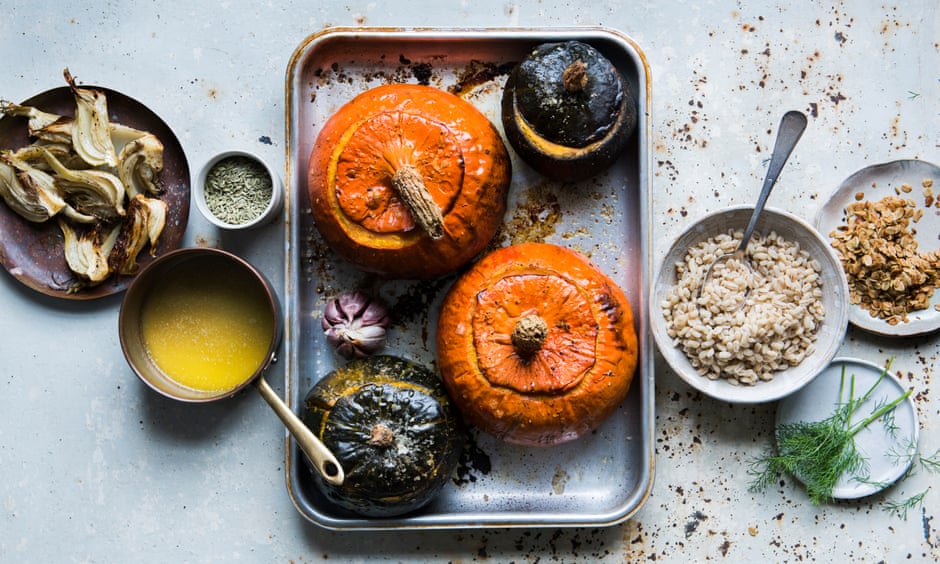
Whole roast squash
Serves 4
Ingredients
A mixture of whole squashes: about 750g squash per person
4 fennel bulbs—keep the lacy fronds at the top
1 garlic bulb (leave it whole)
Olive oil
Salt and black pepper
250g pearl barley
125g sharp cheddar or other cheese
1 lemon, zested
1 red chilli, deseeded if you like
A knob of butter
50g rolled oats
1 tsp fennel seeds
Preparation
Preheat the oven to 180C. Use a big, heavy knife to cut off the base of each squash, so they sit upright on a tray. Cleanly cut the top off each one in a single piece (you are going to put the tops back on) about 3-4cm from the top. Use a metal spoon to scoop out the seeds and the fibres until you have a neat hollow.
Trim the fennel, removing any tough outer leaves, then cut the bulb into a few big wedges. Keep those fronds!
Put the squash in a large roasting tray or two. Scatter the fennel wedges around and put the bulb of garlic on too. Drizzle the lot with olive oil, making sure you get inside the squash, and season with salt and pepper. Put the tops back on the squash. Roast for 45-60 minutes, or until the squash are tender and the fennel has started to soften and brown. If your squash take a little longer, you can remove the fennel once it’s nicely soft and brown around the edges, as you don’t want it to overcook.
Meanwhile, put the pearl barley in a medium pan and cover with cold water. Add a big pinch of salt, then bring to the boil and simmer until al dente (about 25-30 minutes). Drain and transfer to a large bowl.
Remove the garlic and fennel from the roasting dish. When cool enough to handle, squeeze the roasted garlic out of its papery skins, into the barley. Roughly chop the fennel and add it to the bowl along with the cheese, lemon zest, salt and pepper. Chop the fennel fronds to make about a quarter cup. Chop the chilli and add both. Taste the mixture and adjust the seasoning.
Divide the mixture between the squash and return them to the oven for 10 more minutes. Meanwhile, heat some butter in a small pan. Toss in the oats, fennel seeds, and a little salt and pepper. Stir for about 5 minutes, until the flakes are golden. Drain on a plate lined with kitchen paper.
Once the squash are out of the oven, sprinkle over the toasted oats and serve.
Recipe adapted from Anna Jones, The Guardian, 24 Oct. 2016
Help us buy more land for our community!
Please donate to Canalside Community Food
Canalside Community Food has always relied on the rent of neighbouring Leasowe Farm’s land for our fruit.
Canalside now has the opportunity to purchase an adjacent field of 2.25 acres (see map below) so that we can plant an orchard on land that we own, and safeguard the availability of our own fresh fruit for the future.

At our most recent AGM, we agreed to put £10,000 of our reserve funds towards this purchase. That still leaves us short by between £15,000-£20,000, so we agreed to appeal for donations from the wonderful community that we serve.
We would therefore appeal to anyone who shares our vision and passion for Canalside Community Food to donate what they can for this investment in the future of Canalside and the diversity we can offer.
Not only will this purchase enable us to plant and maintain an orchard on our own land in perpetuity, but it will also increase the value of the current land, and provide a wonderful new area for the entire community to enjoy.
We need to finalise this wonderful opportunity by Spring 2021, and would be extremely grateful for any donation you can make before then.
For further information, please contact Gareth Davies.
To donate, please complete the donation form and we will be in touch with you about making your payment. And as a thank you for donating, you will get a beautiful poster of images from Canalside.
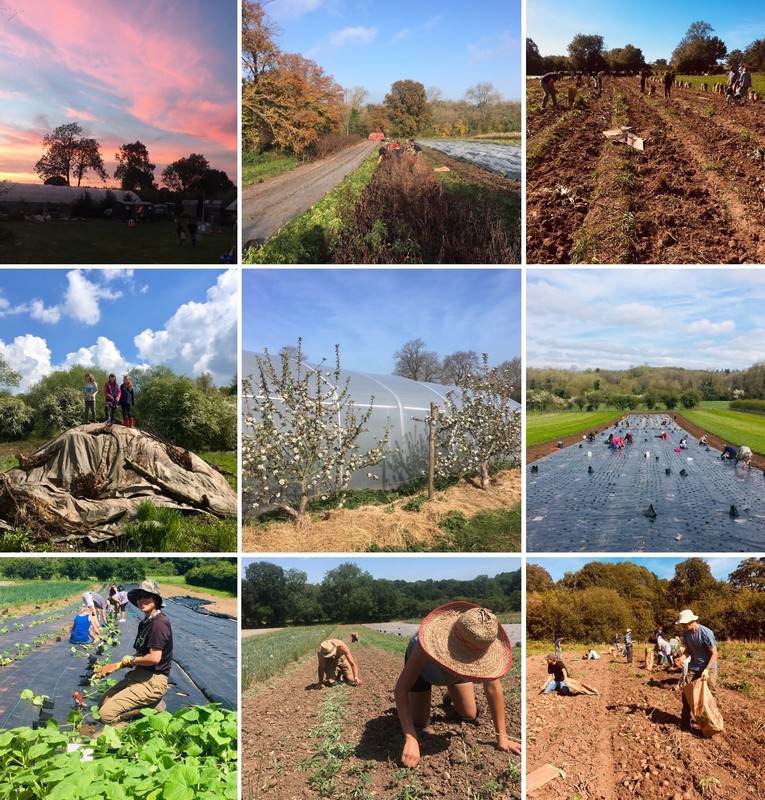
Still available: Job opportunity at Canalside – main grower
We continue to look for a new grower!
Canalside Community Food, a pioneering CSA based outside Leamington Spa, is looking for a new main grower. We are seeking an experienced grower to join our team producing organic vegetables and fruit throughout the year for our community of nearly 200 members.
The successful candidate will work in collaboration with the assistant growers, administration team and seasonal staff, as well as the steering committee and volunteers. The main grower will take a key role in organising and leading the day-to-day management of the farm which includes organising and leading volunteer work mornings, working from and adapting an established rotation and cropping plan, operating a tractor and various manual tools, and reporting to the steering committee.
We are looking for somebody to commit to this fantastic opportunity for at least three seasons. We currently have 7 acres of field scale vegetables, 7 large polytunnels for protected cropping and a 2 acre orchard of top and soft fruit. This position is full-time (37.5 hours per week March-October, 30 per week Nov-Feb) with basic salary of £20,229, statutory holiday allowance and a pension offered.
More details and full job description here
Applications by CV and covering letter to mail@canalsidecommunityfood.org.uk.
You are strongly encouraged to contact us as soon as possible to express interest in the role, and discuss the position and application timelines (including visit/interview); we are wanting to appoint at the earliest opportunity so that the new grower can start by the beginning of the new season.
2020: November news – Heart Beets
It was the final big seasonal workday of 2020, my final one as head grower here, and hopefully the last one we’ll ever have to do under lockdown, fingers crossed… and it was wonderful, with eager beet-pickers of all ages defying the wet weather forecast and ripping red roots from the earth from sunrise (well, it was 10am and there wasn’t any sun, but I’m pleading artistic licence). All in all we picked 990 kilos of which about a quarter is the golden variety. They are all tucked away clamped in sand at the back of the barn – huge thanks to the clamping team, the unsung heroes of the day. Beets store well in this way until June, so there’ll be lots to look forward to in 2021!

The beet harvest in progress 
Beet clamping
Rob’s Recipe of the Week: Mini stuffed squash
I can’t remember the name of the mini squashes we got this week, but I felt they were too special just to cube and roast like normal, so here I’ve found a fun stuffed squash recipe which although aimed at a different variety, I hope will translate across. Enjoy!
INGREDIENTS
3 sweet dumpling squashes
1 tablespoon olive oil
1 small onion, diced (about 1/2 cup)
1/4 cup shelled pistachios, coarsely chopped
8 dates, coarsely chopped (about 1/4 cup)
1 teaspoon lemon zest
1 teaspoon cinnamon
1 cup cooked quinoa
Salt and freshly ground black pepper
INSTRUCTIONS
Preheat oven to 190C.
Cut squash in half and scoop out seeds. (The seeds can be roasted like pumpkin seeds.)
Place squash face-down in an oiled baking dish. Bake until tender when pierced with a knife, about 30 minutes. Remove squash from oven but keep oven on.
Prepare the stuffing while the squash is baking. Heat oil in a medium saucepan over medium heat. Add onions and sauté until onion is translucent. Add pistachios, dates, lemon zest, and cinnamon and sauté for another minute. Stir in the cooked quinoa and season to taste with salt and pepper.
Turn the squash upright in the baking dish and stuff with the quinoa mixture.
Cover dish and bake for another 20 minutes.
Serve warm, garnished with extra pistachios or lemon zest, if desired. The peel of sweet dumpling squash is generally tender enough to be eaten.
From https://www.thekitchn.com/recipe-quinoa-stuffed-sweet-du-72643